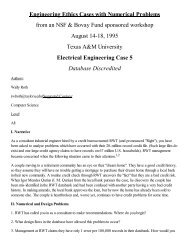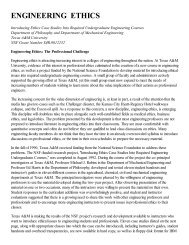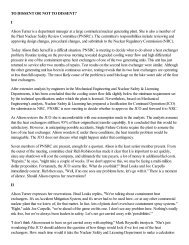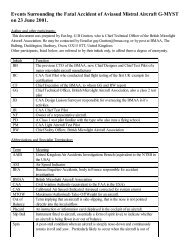High Voltage Lines - Engineering Ethics
High Voltage Lines - Engineering Ethics
High Voltage Lines - Engineering Ethics
Create successful ePaper yourself
Turn your PDF publications into a flip-book with our unique Google optimized e-Paper software.
<strong>Engineering</strong> <strong>Ethics</strong> Cases with Numerical Problems<br />
from an NSF & Bovay Fund sponsored workshop<br />
August 14-18, 1995<br />
Electrical <strong>Engineering</strong> Case 8<br />
<strong>High</strong> <strong>Voltage</strong> <strong>Lines</strong><br />
Authors: Suggested Courses:<br />
Michael Hamid Antenna Thy/Des<br />
(mhamid@jaguar1.usouthal.edu) Level:<br />
Junior<br />
I. Narrative<br />
Electrical energy involves power generation, transmission, and distribution. The latter two involve DC or AC<br />
lines with varying voltages. The largest known DC voltage is approximately 1 million volts. AC transmission lines<br />
employ voltages ranging from 66 kilovolts to several hundred thousand kilovolts. Since there are no high voltage<br />
DC lines in cities, the only concern is from high voltage AC lines to substations. These lines carry currents<br />
producing circumferential magnetic fields which exceed the IEEE standard (about .4 microWebers/ square meter<br />
for magnetic flux density and .03 W/kg for S.A.R.).<br />
These lines produce high intensity electromagnetic fields. The most recent concern has been the magnetic fields<br />
from high voltage transmission lines in residential areas. Possible effects of the magnetic fields are malignant<br />
tumors and genetic mutations.<br />
The voltage in residential areas is constantly increasing because of the rising number of lines, the higher voltages<br />
being used, and the number of homes being built near them. It seems that the highest exposure times correspond<br />
to the times of day that the electrical power consumption is the highest.<br />
The easiest way to minimize the magnetic flux density levels to individuals is to build homes such that a grounded,<br />
metallic, mesh screen is installed on the roof and in the walls while the house is being constructed.<br />
II. Numerical and Design Problems<br />
1. Calculate the magnetic field intensity (H), the magnetic flux density (B), and the<br />
electrical field intensity (E) for various values of line voltage as a function of distance
and plot your answers on a coordinate system. (Start with a voltage value of 230 kV and<br />
a distance of 100 meters.) Estimate the corresponding specific absorption rate (S.A.R.) values for whole body<br />
exposure ( [1],[2] ).<br />
2. Calculate the same values as in question 1 for varying values of line current as a<br />
function of distance. Plot your findings. (Start with a current of 100 Amperes).<br />
3. Assume that the subject is completely enclosed in a grounded, mesh screen (1mm 2 mesh). What effects would<br />
this have on the H, B, and E (at 230 kV, 100 Amp, and 100m)?<br />
4) Repeat question 3 for a typical home that is protected by the same mesh screen. (Make<br />
assumptions as necessary).<br />
III. Questions on <strong>Ethics</strong> and Professionalism<br />
1. A real estate agency hires a contracting firm to build a subdivision in a certain rural area. The job is worth<br />
millions of dollars to the firm. When the contractors visit the site they see that there are high voltage power lines<br />
in great numbers running over it. They approach the real estate company with a suggestion of installing the<br />
protective mesh in the homes. After discussing the price increase involved, the real estate agency refuses to pay<br />
for the protection. Should engineers employed by the contractors recommend that the contractors build the<br />
homes without the mesh or should they absorb the cost themselves?<br />
2. What about homes that are already built? If power companies put high voltage power lines in an already<br />
existing residential area, who would the burden of cost fall on?<br />
References<br />
[1] Gandhi, O.P. 1990. Biological Effects and Medical Applications of Electromagnetic Energy. Prentice-Hall.<br />
[2] Kraus, John D. 1988. Antennas 2 nd Edition. McGraw-Hill. Chapter 5.<br />
IV. Solutions<br />
1)and 2) The magnetic field intensity at a radial distance r from the axis of the conductor carrying current I is<br />
given by:<br />
H = I / (2r) = 100/ (2r) = 1/2 Amps/m<br />
and the magnetic flux density as<br />
B = o H when o = 4 * 10 7 Henry's/m
These plot as a family of hyperbolae starting at infinity (for r o) and going to zero (for r 0s). As I increases, the<br />
curves shirt further into the first quandrant.<br />
Assuming I = 100 Amps and r = 100m we obtain<br />
B = 4 * 10 7 ( 100 \ (2 * 100) ) = .2 microWebers/ m 2<br />
3) and 4) The idea of the mesh screen is to alleviate the radiation going into the subject or home. So hopefully the<br />
values of H, B, and E will be zero. This is somewhat of a design problem.<br />
V. Solutions to Questions on <strong>Ethics</strong> and Professionalism<br />
The IEEE code requires engineers to "accept responsibility in making engineering decisions consistent with the<br />
safety, health, and welfare of the public, and to disclose promptly factors that might endanger the public or the<br />
environment." True, the engineer's minimal responsibility is to make it known to employers and perhaps others in<br />
authority when they believe technology poses a threat to public health, safety and welfare.<br />
There is evidence that transmission lines do pose such a threat, so engineers employed by contractors have a<br />
responsibility to make the dangers known and recommend solutions. But, the National Society of Professional<br />
Engineers (NSPE) code requires engineers to "protect" the health and safety of the public. This may require<br />
engineers to do more than simply inform authorities of the problem. Even if it does not, the engineer's personal<br />
morality may require more.<br />
If the law does not require the installation of the metallic mesh screens, engineers who might be involved in the<br />
design of the subdivisions or other facilities related to the project have the choice of complying with the<br />
contractor's wishes or not participating in the project. If they back out, they know that their own refusal will not<br />
keep the unprotected houses from being built, they should probably refuse to participate in the project.<br />
Otherwise, they will be participating in something they believe poses a substantial risk to public health.<br />
If engineers are convinced that the transmission lines pose a serious health problem, they should probably also<br />
encourage their professional societies to lobby for legislation requiring installation of the metallic mesh screens in<br />
areas exposed to high intensity electromagnetic fields.<br />
If engineers are asked to design transmission lines through residential areas where the homes are not protected,<br />
and if they are convinced that the lines pose a serious health risk, they should insist that the residents be warned<br />
of the danger. Again, engineers might want to encourage their professional societies to lobby for legislation<br />
requiring that transmission lines not be built near existing homes, or that the homes be properly protected.













